Charles E W Bean, Diaries, AWM38 3DRL 606/244/1 - 1916 - 1933 - Part 25
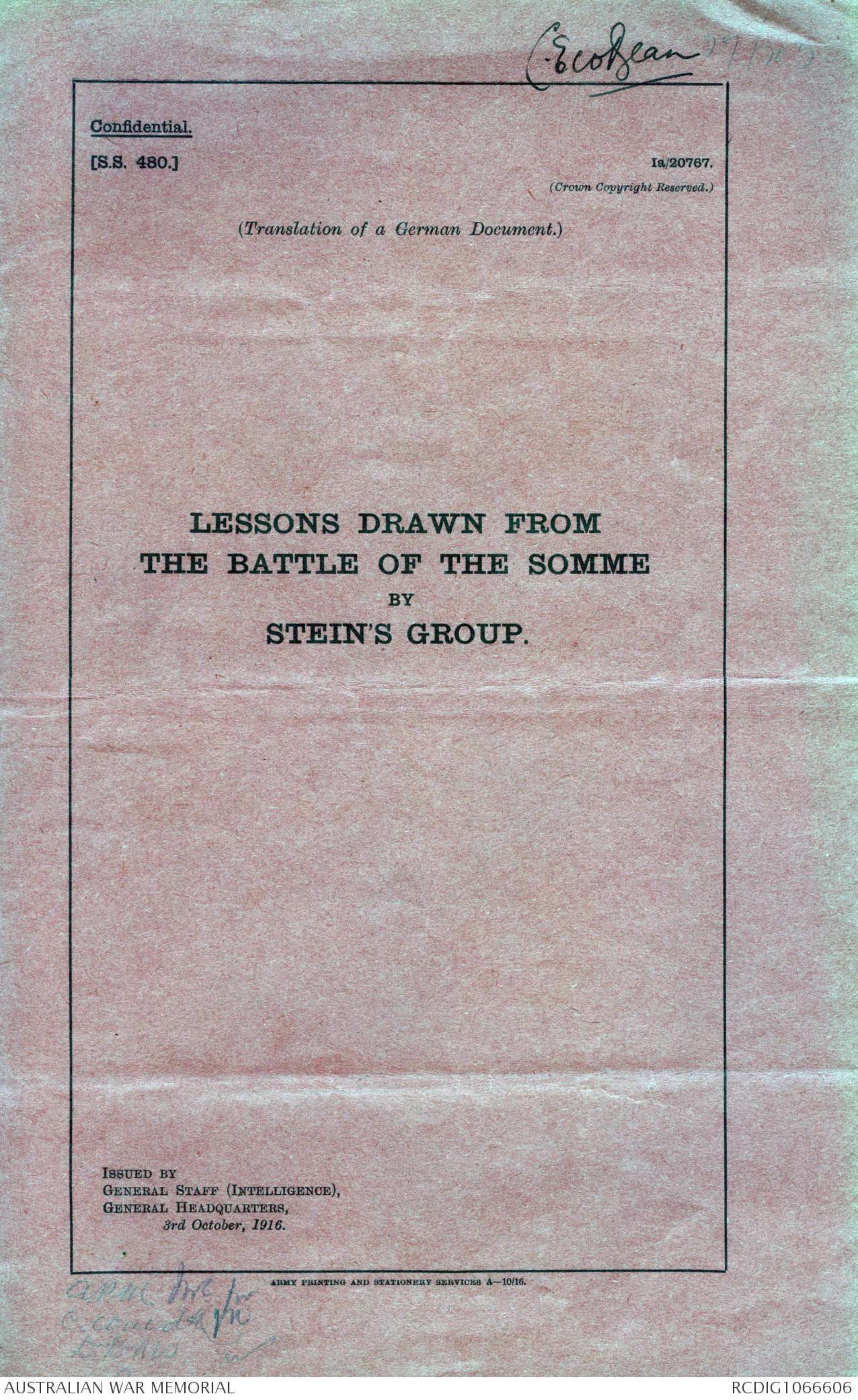
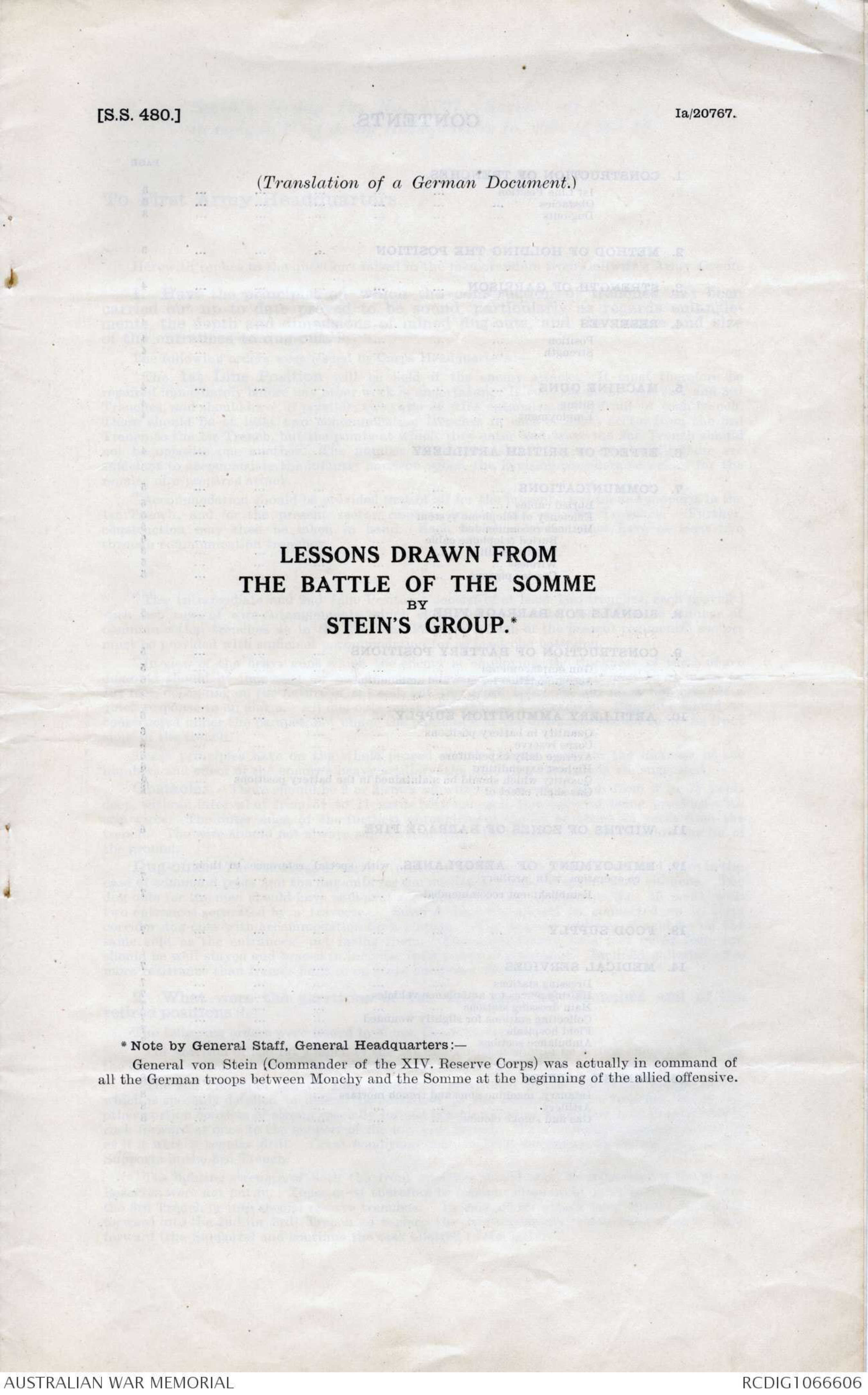


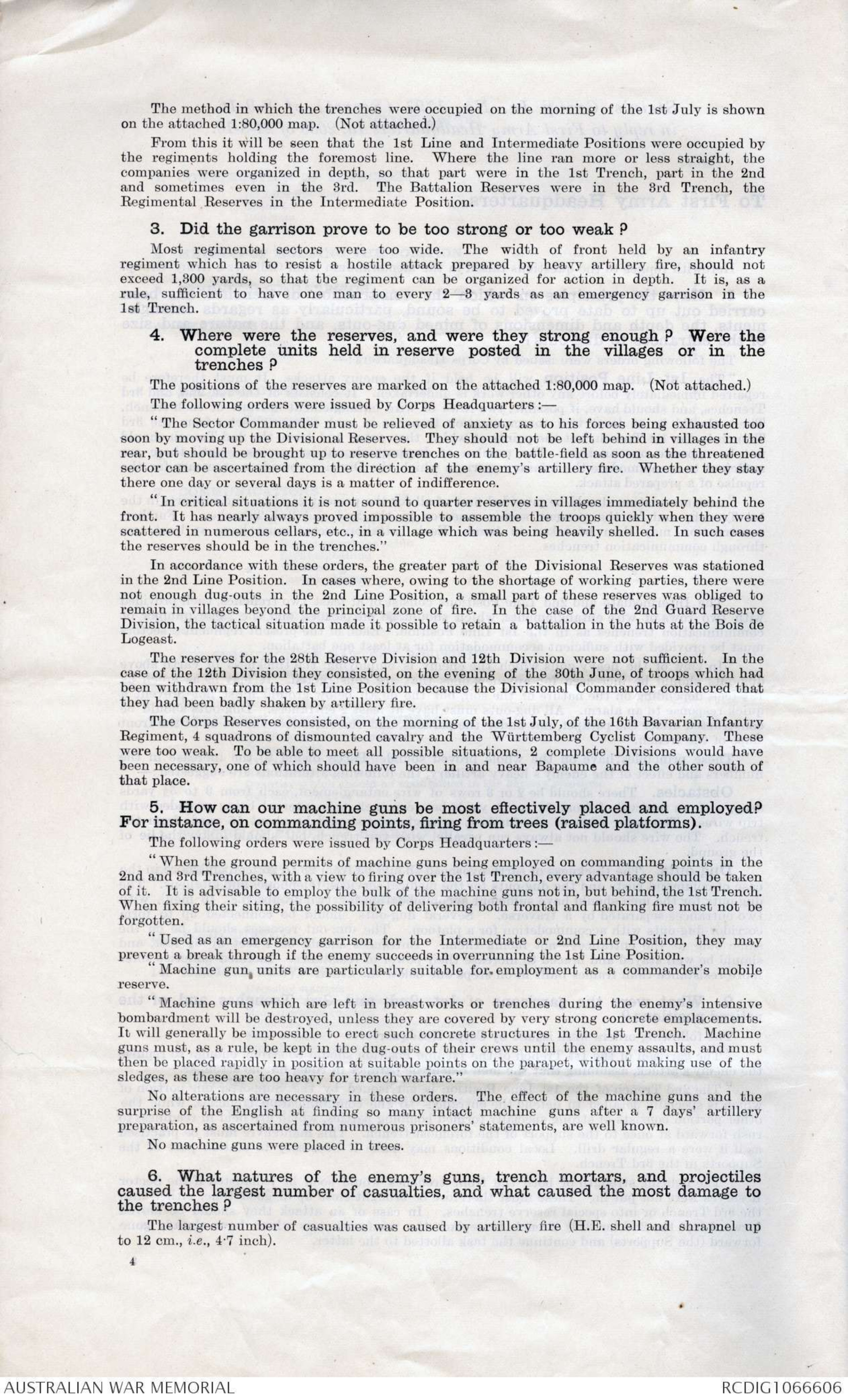
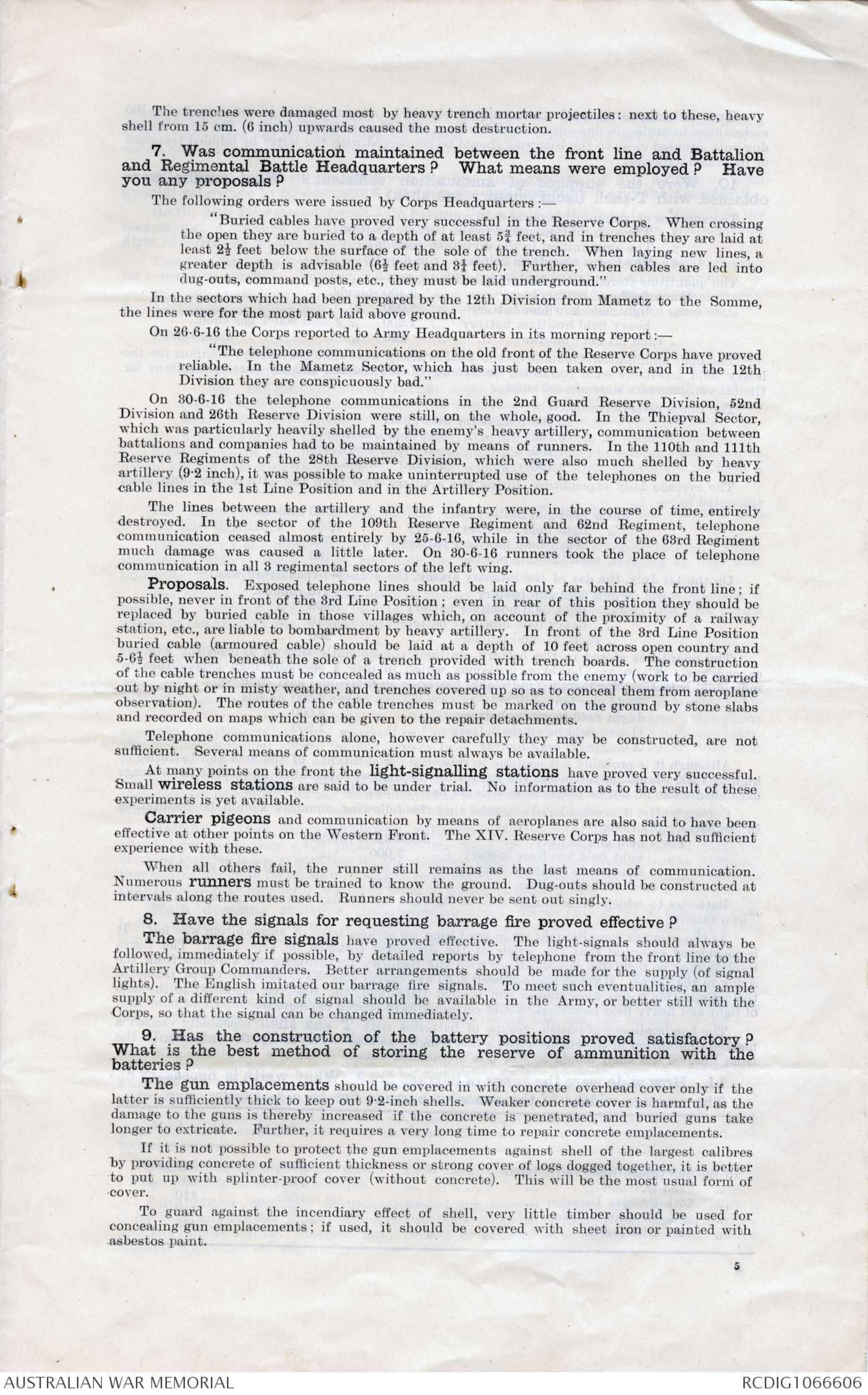
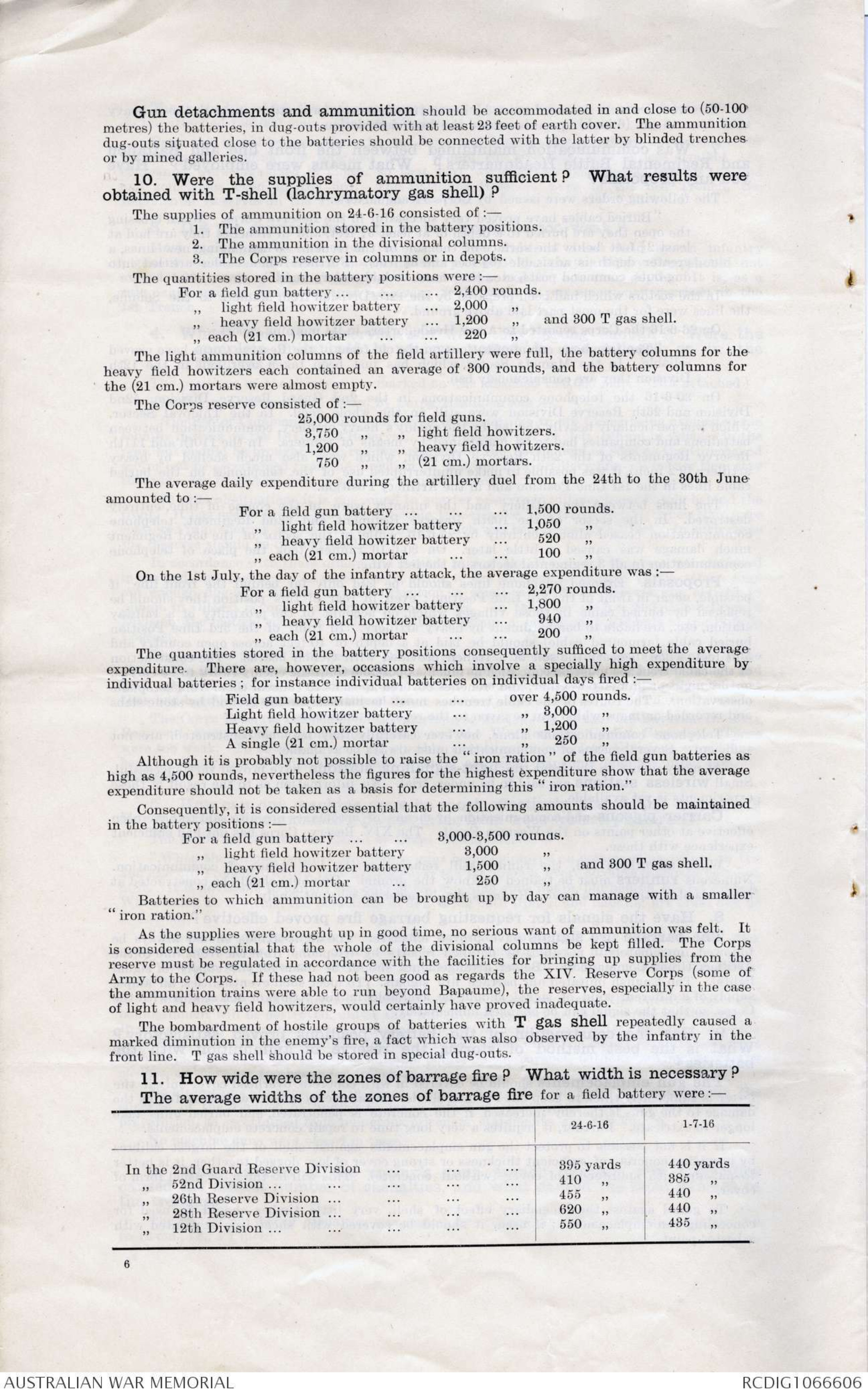

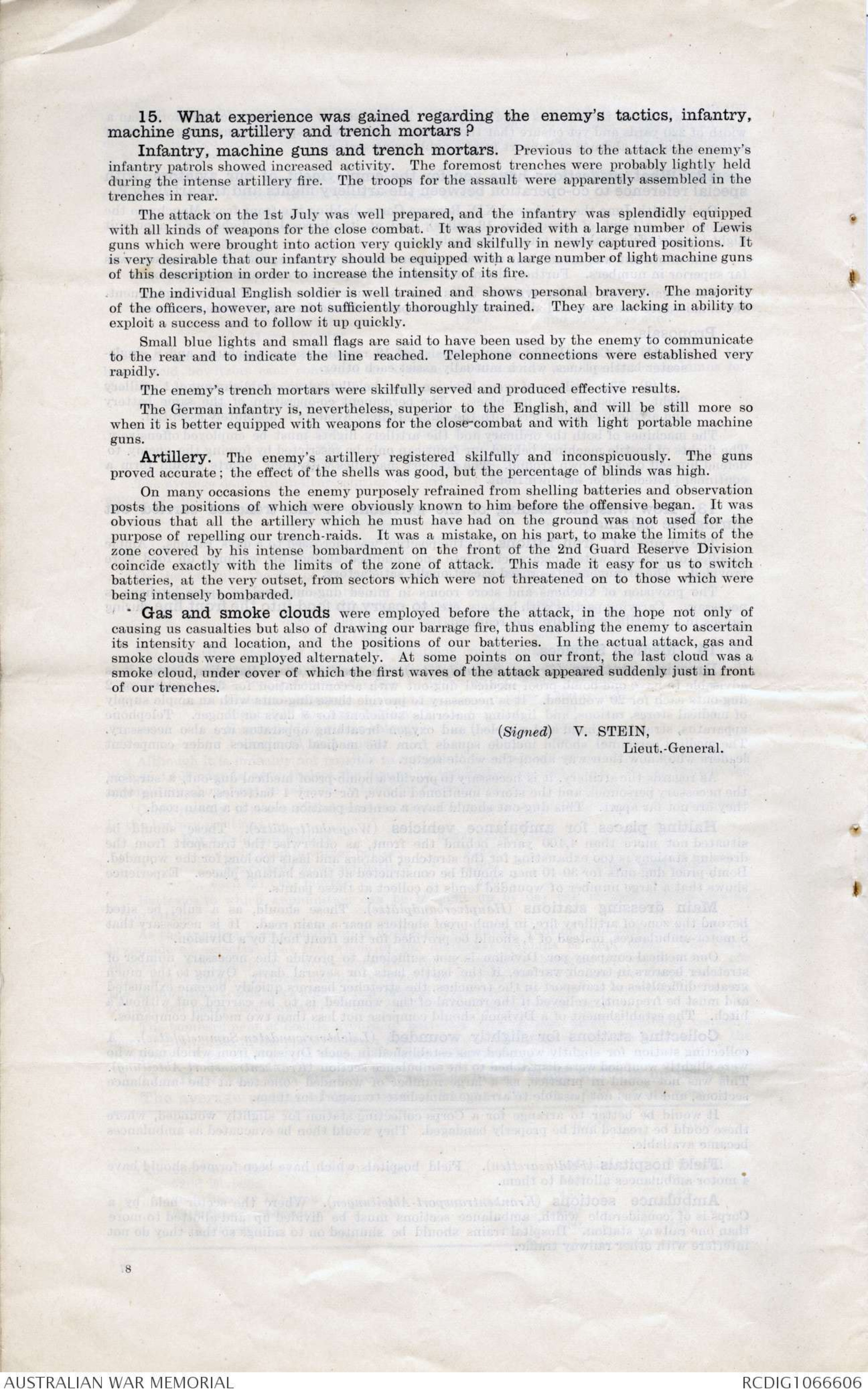
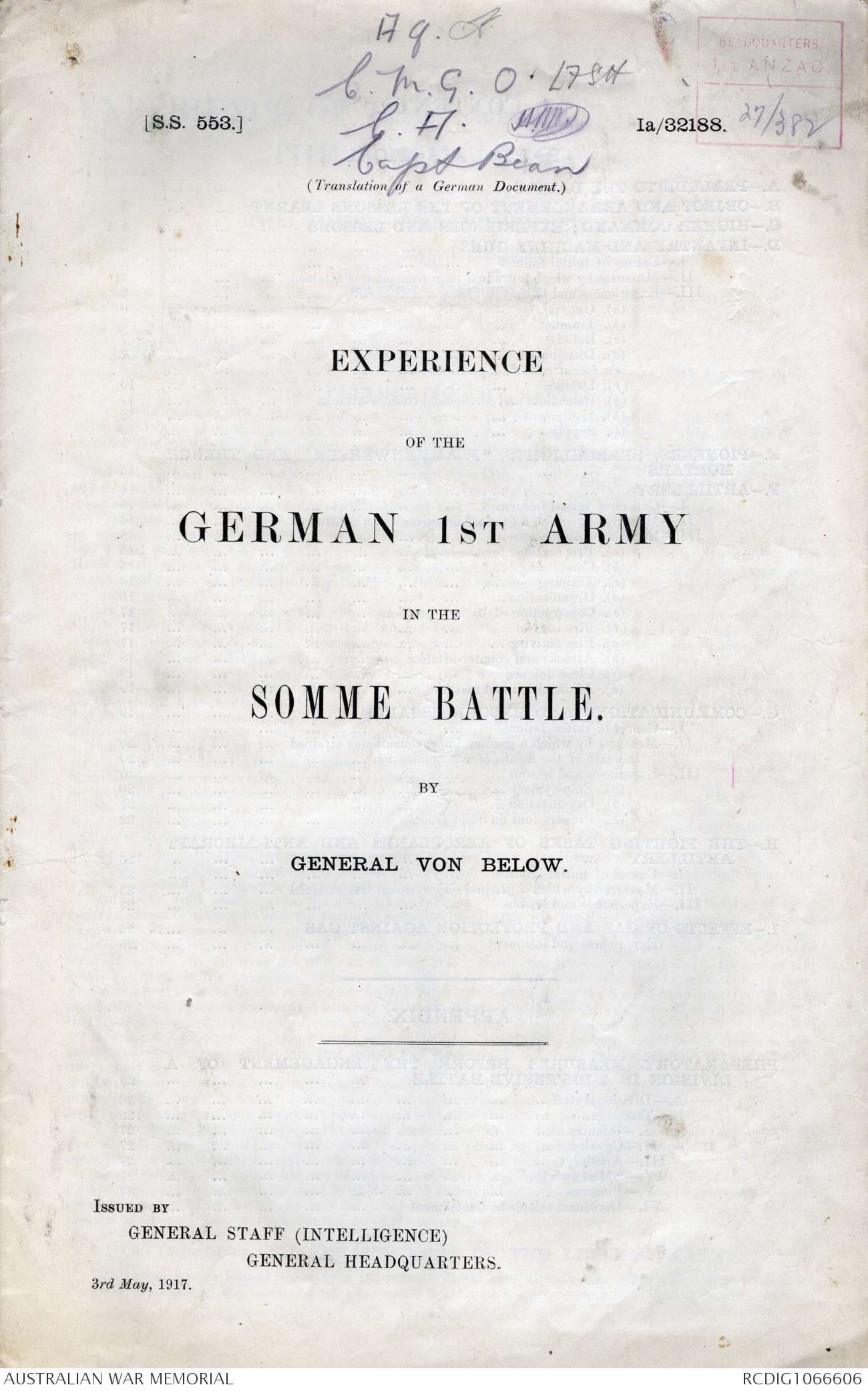
CEW Bean
Confidential
[S.S. 480.] Ia/20767.
(Crown Copyright Reserved.)
(Translation of a German Document.)
LESSONS DRAWN FROM
THE BATTLE OF THE SOMME
BY
STEIN'S GROUP.
ISSUED BY
GENERAL STAFF (INTELLIGENCE),
GENERAL HEADQUARTERS,
3rd October, 1916.
ARMY PRINTING AND STATIONERY SERVICES A-10/16.
[[?initials]] JWC for [[?]]
[[?initials]]
[[?initials]]
[S.S. 480.] Ia/20767.
(Translation of a German Document)
LESSONS DRAWN FROM
THE BATTLE OF THE SOMME
BY
STEINS GROUP.*
*Note by General Staff, General Headquarters:-
General von Stein (Commander of the XIV. Reserve Corps) was actually in command of
all the German troops between Monchy and the Somme at the beginning of the allied offensive.
CONTENTS.
| PAGE | ||
| 1. | CONSTRUCTION OF TRENCHES. | |
| 1st Line Position | 3 | |
| Obstacles | 3 | |
| Dug outs | 3 | |
| 2. | METHOD OF HOLDING THE POSITION | 3 |
| 3. | STRENGTH OF GARRISON | 4 |
| 4. | RESERVES | 4 |
| Position | 4 | |
| Strength | 4 | |
| 5. | MACHINE GUNS | 4 |
| Siting | 4 | |
| Employment | 4 | |
| 6. | EFFECT OF BRITISH ARTILLERY | 4 |
| 7. | COMMUNICATIONS | 5 |
| Buried cables | 5 | |
| Efficiency of telephone system | 5 | |
| Methods recommended | 5 | |
| Buried telephone cable | 5 | |
| Light-signalling | 5 | |
| Wireless | 5 | |
| Carrier pigeons | 5 | |
| 8. | SIGNALS FOR BARRAGE FIRE | 5 |
| 9. | CONSTRUCTION OF BATTERY POSITIONS | 5 |
| Gun emplacements | 5 | |
| Accommodation for men and ammunition | 6 | |
| 10. | ARTILLERY AMMUNITION SUPPLY | 6 |
| Quantity in battery positions | 6 | |
| Corps reserve | 6 | |
| Average daily expenditure | 6 | |
| Highest expenditure | 6 | |
| Quantity which should be maintained in the battery positions | 6 | |
| Gas shell, effect of | 6 | |
| 11. | WIDTHS OF ZONES OF BARRAGE FIRE | 6 |
| 12. | EMPLOYMENT OF AEROPLANES, with special reference to their | |
| co-operation with artillery | 7 | |
| Establishment recommended | 7 | |
| 13. | FOOD SUPPLY | 7 |
| 14. | MEDICAL SERVICES | 7 |
| Dressing stations | 7 | |
| Halting places for ambulance vehicles | 7 | |
| Main dressing stations | 7 | |
| Collecting stations for slightly wounded | 7 | |
| Field hospitals | 7 | |
| Ambulance sections | 7 | |
| 15. | BRITISH TACTICS | 8 |
| Infantry, machine guns and trench mortars | 8 | |
| Artillery | 8 | |
| Gas and smoke clouds | 8 |
Steins Group Ia. No. 1797 (Secret) of 8-9-16,
in reply to First Army Headquarters Ia. 2638 of 24-8-16.
To First Army Headquarters.
Herewith replies to the questions raised in the memorandum from Gallwitz's Army Group.
1. Have the principles on which the construction of trenches has been
carried out up to date proved to be sound, particularly as regards entangle-
ments, the depth and dimensions of mined dug-outs, and the nature and size
of the entrances to dug-outs?
The following orders were issued by Corps Headquarters:-
"The 1st Line Position will be held if the enemy attacks. It must therefore be
repaired immediately before any other work is undertaken. It consists of the 1st, 2nd, and 3rd
Trenches, and should have, if possible, two rows of wire entanglement in front of each trench.
There should be at least two communication trenches in each company sector from the 3rd
Trench to the 1st Trench, but the points at which they enter and leave the 2nd Trench should
not be opposite one another. The number of dug-outs should be increased until there are
sufficient to accommodate the infantry garrison which the Division considers necessary for the
repulse of a prepared attack.
"Accommodation should be provided first of all for the present garrison and supports in the
1st Trench, and for the present sector reserves in the 2nd and 3rd Trenches. Further,
construction may then be taken in hand. Each battalion sector must have at least two
through communication trenches.
* * * * *
"The Intermediate and 2nd Line Positions consist of at least two trenches, each provided
with two rows of wire entanglements, which should be on pickets, and the same number of
communication trenches as in the 1st Line Position. Each of the present regimental sectors
must be provided with sufficient accommodation for at least one battalion.
"In view of the heavy guns which the enemy is employing, the thickness of earth above
dug-outs should be increased for any new ones that are constructed. It may be as much as
19½ feet, depending on the nature of the soil, but the depth below ground must not prevent a
quick response to an alarm. All dug outs must have at least 2 entrances. Dug outs should be
constructed under the parapet, not under the parados, and the entrances should be in the front
slope of the trench."
These principles have on the whole proved sound. Partly owing to the increase in the
numbers and effect of the enemy's heavy artillery, the following alterations are suggested: -
Obstacles. There should be 2 or 3 rows of wire entanglement, each from 3 to 5½ yards
deep, with an interval of from 5½ to 11 yards between each, this interval being provided with
trip wires. The outer edge of the furthest entanglement should be about 55 yards from the
trench. The wire should not always run parallel with the trench, but should follow the lie of
the ground.
Dug-outs. The thickness of earth overhead should be from 23 to 26 feet, and more in the
case of command posts and the dug-outs for the medical services, telephones and kitchens. The
dug outs for the men should have sufficient accommodation for two groups (i.e., 16 men), with
two entrances separated by a traverse. Several dug-outs should be connected up to form
corridor-dug-outs with accommodation for a platoon. The dug-out recesses should be on the
same side as the entrances—not facing them. Entrances should be 4 feet by 5¼ feet, and
should be well stayed and braced to increase their power of resistance. Inclined galleries offer
more resistance than frames built in on steps one below the other.
2. What were the garrisons of the 1st, 2nd, and 3rd Trenches and of the
retired positions?
The following orders were issued by Corps Headquarters:-
"The garrison of the 1st Trench of the 1st line Position should be strong enough to repulse
the enemy's attack, assuming that the men reach the parapet in time, but no stronger.
"The 2nd Trench of the 1st Line Position is garrisoned by the Supports, one portion of
which is specially detailed to defend the entrances to the communication trenches, while the
other portion consists of strong specially formed bombing parties, which are held in readiness to
rush forward at once to the support of the foremost trench. This manœuvre must be practised
as if it were a regular drill. Local conditions may make it necessary to station part of the
Supports in the 3rd Trench.
"The fighting strength of both the front trenches would soon be exhausted if the Sector
Reserves were not put in. These must therefore be brought close up in good time, either into
the 3rd Trench or into special reserve trenches. In case of an attack they should be moved
forward into the 2nd (or 3rd) Trench to replace the reinforcements which have already gone
forward (the Supports) and continue the task allotted to the latter."
3
The method in which the trenches were occupied on the morning of the 1st July is shown
on the attached 1:80,000 map. (Not attached.)
From this it will be seen that the 1st Line and Intermediate Positions were occupied by
the regiments holding the foremost line. Where the line ran more or less straight, the
companies were organized in depth, so that part were in the 1st Trench, part in the 2nd
and sometimes even in the 3rd. The Battalion Reserves were in the 3rd Trench, the
Regimental Reserves in the Intermediate Position.
3. Did the garrison prove to be too strong or too weak?
Most regimental sectors were too wide. The width of front held by an infantry
regiment which has to resist a hostile attack prepared by heavy artillery fire, should not
exceed 1,300 yards, so that the regiment can be organized for action in depth. It is, as a
rule, sufficient to have one man to every 2-3 yards as an emergency garrison in the
1st Trench.
4. Where were the reserves, and were they strong enough? Were the
complete units held in reserve posted in the villages or in the
trenches?
The positions of the reserves are marked on the attached 1:80,000 map. (Not attached.)
The following orders were issued by Corps Headquarters:–
"The Sector Commander must be relieved of anxiety as to his forces being exhausted too
soon by moving up the Divisional Reserves. They should not be left behind in villages in the
rear, but should be brought up to reserve trenches on the battle-field as soon as the threatened
sector can be ascertained from the direction of the enemy's artillery fire. Whether they stay
there one day or several days is a matter of indifference.
"In critical situations it is not sound to quarter reserves in villages immediately behind the
front. It has nearly always proved impossible to assemble the troops quickly when they were
scattered in numerous cellars, etc., in a village which was being heavily shelled. In such cases
the reserves should be in the trenches.
In accordance with these orders, the greater part of the Divisional Reserves was stationed
in the 2nd Line Position. In cases where, owing to the shortage of working parties, there were
not enough dug-outs in the 2nd Line Position, a small part of these reserves was obliged to
remain in villages beyond the principal zone of fire. In the case of the 2nd Guard Reserve
Division, the tactical situation made it possible to retain a battalion in the huts at the Bois de
Logeast.
The reserves for the 28th Reserve Division and 12th Division were not sufficient. In the
case of the 12th Division they consisted, on the evening of the 30th June, of troops which had
been withdrawn from the 1st Line Position because the Divisional Commander considered that
they had been badly shaken by artillery fire.
The Corps Reserves consisted, on the morning of the1st July, of the 16th Bavarian Infantry
Regiment, 4 squadrons of dismounted cavalry and the Württemberg Cyclist Company. These
were too weak. To be able to meet all possible situations, 2 complete Divisions would have
been necessary, one of which should have been in and near Bapaume and the other south of
that place.
5. How can our machine guns be most effectively placed and employed?
For instance, on commanding points, firing from trees (raised platforms).
The following orders were issued by Corps Headquarters:
"When the ground permits of machine guns being employed on commanding points in the
2nd and 3rd Trenches, with a view to firing over the 1st Trench, every advantage should be taken
of it. It is advisable to employ the bulk of the machine guns not in, but behind, the 1st Trench.
When fixing their siting, the possibility of delivering both frontal and flanking fire must not be
forgotten.
"Used as an emergency garrison for the Intermediate or 2nd Line Position, they may
prevent a break through if the enemy succeeds in overrunning the 1st Line Position.
"Machine gun units are particularly suitable for employment as a commander's mobile
reserve.
"Machine guns which are left in breastworks or trenches during the enemy's intensive
bombardment will be destroyed, unless they are covered by very strong concrete emplacements.
It will generally be impossible to erect such concrete structures in the 1st Trench. Machine
guns must, as a rule, be kept in the dug-outs of their crews until the enemy assaults, and must
then be placed rapidly in position at suitable points on the parapet, without making use of the
sledges, as these are too heavy for trench warfare."
No alterations are necessary in these orders. The effect of the machine guns and the
surprise of the English at finding so many intact machine guns after a 7 days' artillery
preparation, as ascertained from numerous prisoners' statements, are well known.
No machine guns were placed in trees.
6. What natures of the enemy's guns, trench mortars, and projectiles
caused the largest number of casualties, and what caused the most damage to
the trenches?
The largest number of casualties was caused by artillery fire (H.E. shell and shrapnel up
to 12 cm., ie., 4.7 inch).
4
The trenches were damaged most by heavy trench mortar projectiles: next to these, heavy
shell from 15 cm (6inch) upwards caused the most destruction.
7. Was communication maintained between the front line and Battalion
and Regimental Battle Headquarters? What means were employed? Have
you any proposals?
The following orders were issued by Corps Headquarters:-
"Buried cables have proved very successful in the Reserve Corps. When crossing
the open they are buried to a depth of at least 5¾ feet, and in trenches they are laid at
least 2½ feet below the surface of the sole of the trench. When laying new lines, a
greater depth is advisable (6½ feet and 3¼ feet). Further, when cables are led into
dug-outs, command posts, etc., they must be laid underground."
In the sectors which had been prepared by the 12th Division from Mametz to the Somme,
the lines were for the most part laid above ground.
On 26-6-16 the Corps reported to Army Headquarters in its morning report: -
"The telephone communications on the old front of the Reserve Corps have proved
reliable. In the Mametz Sector, which has just been taken over, and in the 12th
Division they are conspicuously bad."
On 30-6-16 the telephone communications in the 2nd Guard Reserve Division, 52nd
Division and 26th Reserve Division were still, on the whole, good. In the Thiepval Sector,
which was particularly heavily shelled by the enemy's heavy artillery, communication between
battalions and companies had to be maintained by means of runners. In the 110th and 111th
Reserve Regiments of the 28th Reserve Division, which were also much shelled by heavy
artillery (9.2 inch), it was possible to make uninterrupted use of the telephones on the buried
cable lines in the 1st Line Position and in the Artillery Position.
The lines between the artillery and the infantry were, in the course of time, entirely
destroyed. In the sector of the 109th Reserve Regiment and 62nd Regiment, telephone
communication ceased almost entirely by 25-6-16, while in the sector of the 63rd Regiment
much damage was caused a little later. On 30-6-16 runners took the place of telephone
communication in all 3 regimental sectors of the left wing.
Proposals. Exposed telephone lines should be laid only far behind the front line; if
possible, never in front of the 3rd Line Position; even in rear of this position they should be
replaced by buried cable in those villages which, on account of the proximity of a railway
station, etc., are liable to bombardment by heavy artillery. In front of the 3rd Line Position
buried cable (armoured cable) should be laid at a depth of 10 feet across open country and
5-6½ feet when beneath the sole of a trench provided with trench boards. The construction
of the cable trenches must be concealed as much as possible from the enemy (work to be carried
out by night or in misty weather, and trenches covered up so as to conceal then from aeroplane
observation). The routes of the cable trenches must be marked on the ground by stone slabs
and recorded on maps which can be given to the repair detachments.
Telephone communications alone, however carefully they may be constructed, are not
sufficient. Several means of communication must always be available.
At many points on the front the light-signalling stations have proved very successful.
Small wireless stations are said to be under trial. No information as to the result of these
experiments is yet available.
Carrier pigeons and communication by means of aeroplanes are also said to have been
effective at other points on the Western Front. The XIV. Reserve Corps has not had sufficient
experience with these.
When all others fail, the runner still remains as the last means of communication.
Numerous runners must be trained to know the ground. Dug-outs should be constructed at
intervals along the routes used. Runners should never be sent out singly.
8. Have the signals for requesting barrage fire proved effective?
The barrage fire signals have proved effective. The light-signals should always be
followed, immediately if possible, by detailed reports by telephone from the front line to the
Artillery Group Commanders. Better arrangements should be made for the supply (of signal
lights). The English imitated our barrage fire signals. To meet such eventualities, an ample
supply of a different kind of signal should be available in the Army, or better still with the
Corps, so that the signal can be changed immediately.
9. Has the construction of the battery positions proved satisfactory?
What is the best method of storing the reserve of ammunition with the
batteries?
The gun emplacements should be covered in with concrete overhead cover only if the
latter is sufficiently thick to keep out 9.2-inch shells. Weaker concrete cover is harmful, as the
damage to the guns is thereby increased if the concrete is penetrated, and buried guns take
longer to extricate. Further, it requires a very long time to repair concrete emplacements.
If it is not possible to protect the gun emplacements against shell of the largest calibres
by providing concrete of sufficient thickness or strong cover of logs dogged together, it is better
to put up with splinter-proof cover (without concrete). This will be the most usual form of
cover.
To guard against the incendiary effect of shell, very little timber should be used for
concealing gun emplacements; if used, it should be covered with sheet iron or painted with
asbestos paint.
5
Gun detachments and ammunition should be accommodated in and close to (50-100
metres) the batteries, in dug-outs provided with at least 23 feet of earth cover. The ammunition
dug-outs situated close to the batteries should be connected with the latter by blinded trenches
or by mined galleries
10. Were the supplies of ammunition sufficient? What results were
obtained with T-shell (lachrymatory gas shell)?
The supplies of ammunition on 24-6-16 consisted of:-
| 1. | The ammunition stored in the battery positions. |
| 2. | The ammunition in the divisional columns. |
| 3. | The Corps reserve in columns or in depots. |
The quantities stored in the battery positions were:-
| For | a field gun battery |
2,400 |
rounds | |
|
" |
light field howitzer battery |
2,000 |
" |
|
|
" |
heavy field howitzer battery |
1,200 |
" |
and 300 T gas shell. |
|
" |
each (21 cm.) mortar |
220 |
" |
The light ammunition columns of the field artillery were full, the battery columns for the
heavy field howitzers each contained an average of 300 rounds, and the battery columns for
the (21 cm.) mortars were almost empty.
The Corps reserve consisted of:
|
25,000 |
rounds | for | field guns. |
|
3,750 |
" |
" |
light field howitzers. |
|
1,200 |
" |
" |
heavy field howitzers. |
|
750 |
" |
" |
(21 cm.) mortars. |
The average daily expenditure during the artillery duel from the 24th to the 30th June
amounted to:-
| For | a field gun battery |
1,500 |
rounds | |
|
" |
light field howitzer battery |
1,050 |
" |
|
|
" |
heavy field howitzer battery |
520 |
" |
|
|
" |
each (21 cm.) mortar |
100 |
" |
On the lst July, the day of the infantry attack, the average expenditure was:
| For | a field gun battery |
2,270 |
rounds | |
|
" |
light field howitzer battery |
1,800 |
" |
|
|
" |
heavy field howitzer battery |
940 |
" |
|
|
" |
each (21 cm.) mortar |
200 |
" |
The quantities stored in the battery positions consequently sufficed to meet the average
expenditure. There are, however, occasions which involve a specially high expenditure by
individual batteries; for instance individual batteries on individual days fired:-
| Field gun battery |
over |
4,500 |
rounds |
| Light field howitzer battery |
" |
3,000 |
" |
| Heavy field howitzer battery |
" |
1,200 |
" |
| A single (21 cm.) mortar |
" |
250 |
" |
Although it is probably not possible to raise the "iron ration" of the field gun batteries as
high as 4,500 rounds, nevertheless the figures for the highest expenditure show that the average
expenditure should not be taken as a basis for determining this "iron ration."
Consequently, it is considered essential that the following amounts should be maintained
in the battery positions:-
|
For |
a | field gun battery |
3,000-3,500 |
rounds. |
|
|
" |
light field howitzer battery |
3,000 |
" |
||
|
" |
heavy field howitzer battery |
1,500 |
" |
and 300 T gas shell. | |
|
" |
each | A single (21 cm.) mortar |
250 |
" |
Batteries to which ammunition can be brought up by day can manage with a smaller
"iron ration."
As the supplies were brought up in good time, no serious want of ammunition was felt. It
is considered essential that the whole of the divisional columns be kept filled. The Corps
reserve must be regulated in accordance with the facilities for bringing up supplies from the
Army to the Corps. If these had not been good as regards the XIV. Reserve Corps (some of
the ammunition trains were able to run beyond Bapaume), the reserves, especially in the case
of light and heavy field howitzers, would certainly have proved inadequate.
The bombardment of hostile groups of batteries with T gas shell repeatedly caused a
marked diminution in the enemy's fire, a fact which was also observed by the infantry in the
front line. T gas shell should be stored in special dug outs.
11. How wide were the zones of barrage fire? What width is necessary?
The average widths of the zones of barrage fire for a field battery were:-
| 24-6-16 | 1-7-16 | ||||
| In the | 2nd Guard Reserve Division | 395 | yards | 440 | yards |
|
" |
52nd Division | 410 |
" |
385 |
" |
|
" |
26th Reserve Division | 455 |
" |
440 |
" |
|
" |
28th Reserve Division | 620 |
" |
440 |
" |
|
" |
12th Division | 550 |
" |
435 |
" |
6
The widths of these zones were too great. A field battery is unable to cover more than a
width of 220 yards and yet ensure that the barrage is effective in spite of guns being put out of
action and of the absence of support from neighbouring sectors.
12. What suggestions have you for the employment of our aviators, with
special reference to co-operation between the artillery flights and the artillery?
On the 24th June the reinforced XIV Reserve Corps, holding the front from Monchy to the
Somme (i.e., a front of more than 19 miles), had at its disposal 4½ flights and a pursuit
flight (Jagdstaffel), making a total of 28 machines.
This allotment was insufficient to maintain command of the air against the enemy who was
far superior in numbers. Further, the new English battle planes were superior to our own.
The organization of the aviation units was not suited to their effective employment.
Reconnaissance machines and single-seater battle planes should form part of the same unit.
Proposals.
(1) A Corps Flight should consist of 12 reconnaissance machines and 8 single-
seater battle planes, which mutually assist each other.
(2) The artillery of every Division must be allotted an establishment of 1 artillery
flight, consisting of 6 machines. The permanent co-operation of the same battery
and artillery commanders with the same artillery aviators is absolutely essential.
The machines of both the ordinary and the artillery flights must be employed offensively
The flights of hostile machines behind our front can only be restricted by forcing the enemy to
defend himself over his own ground. The artillery machines with their escorts should form a
continual protection for our own front.
13. How was the feeding of the garrisons of the trenches carried out
during the fighting?
The quantity of "iron rations" in the position was increased to 5 days' rations. Ample
supplies of mineral water, cigars, chocolate and solidified alcohol for warming up food were
provided. The arrangements proved exceptionally satisfactory.
The provision of kitchens and store rooms in mined dug-outs and of spare kitchens is
necessary. Carrying parties with baskets, etc., to carry up food into the front line during
pauses in the artillery fire, are also required.
14. Medical Services.
Dressing stations (Truppenverbandplätze). In rear of every Battalion Sector it is
advisable to have one bomb-proof medical dug-out with accommodation for 30 wounded, or 2
dug-outs each for 20 wounded. It is necessary to provide these dug-outs with an ample supply
of medical stores, rations, and lighting materials sufficient for 5 days or longer. Telephone
apparatus, stretchers (hand and wheeled) and oxygen breathing apparatus are also necessary.
The medical personnel should include squads from the medical companies under competent
leaders who know their way about the whole sector.
As regards the artillery, it is necessary to provide a bomb-proof medical dug-out, a surgeon,
the necessary personnel, and the stores mentioned above, for every 4 batteries, assuming that
they are not far apart. This dug-out should have a central position close to a main road.
Halting places for ambulance vehicles (Wagenhalteplätze). These should be
situated not more than 4,400 yards behind the front, as otherwise the transport from the
dressing stations is too exhausting for the stretcher bearers and lasts too long for the wounded.
Bomb-proof dug-outs for 30-40 men should be constructed at these halting places. Experience
shows that a large number of wounded tends to collect at these points.
Main dressing stations (Hauptverbandplätze). These should, as a rule, be sited
beyond the zone of artillery fire, in bomb-proof shelters near a main road. It is necessary that
8 motor-ambulances, instead of 4, should be provided for the front held by a Division.
One medical company per Division is not sufficient to provide the necessary number of
stretcher bearers in trench warfare, if the battle lasts for several days. Owing to the much
greater difficulties of transport in the trenches, the stretcher bearers quickly become exhausted
and must be frequently relieved if the removal of the wounded is to be carried out without a
hitch. The establishment of a Division should comprise not less than two medical companies.
Collecting stations for slightly wounded (Leichtverwundeten-Sammelplätze). A
collecting station for slightly wounded was established in each Division, from which men who
were slightly wounded were dispatched to the ambulance section (Krankentransport-Abteilung).
This was not sound in practice, as a large number of wounded collected at the ambulance
sections, and it was not possible to arrange immediate transport for them.
It would be better to arrange for a Corps collecting station for slightly wounded, where
these could be treated and be properly bandaged. They would then be evacuated as ambulances
became available.
Field hospitals (Feldlazaretten). Field hospitals which have been formed should have
4 motor-ambulances allotted to them.
Ambulance sections (Krankentransport-Abteilungen). Where the sector held by a
Corps is of considerable width, ambulance sections must be divided up and allotted to more
than one railway station. Hospital trains should be shunted on to sidings so that they do not
interfere with other railway traffic.
7
15. What experience was gained regarding the enemy's tactics, infantry,
machine guns, artillery and trench mortars?
Infantry, machine guns and trench mortars. Previous to the attack the enemy's
infantry patrols showed increased activity. The foremost trenches were probably lightly held
during the intense artillery fire. The troops for the assault were apparently assembled in the
trenches in rear.
The attack on the 1st July was well prepared, and the infantry was splendidly equipped
with all kinds of weapons for the close combat. It was provided with a large number of Lewis
guns which were brought into action very quickly and skilfully in newly captured positions. It
is very desirable that our infantry should be equipped with a large number of light machine guns
of this description in order to increase the intensity of its fire.
The individual English soldier is well trained and shows personal bravery. The majority
of the officers, however, are not sufficiently thoroughly trained. They are lacking in ability to
exploit a success and to follow it up quickly.
Small blue lights and small flags are said to have been used by the enemy to communicate
to the rear and to indicate the line reached. Telephone connections were established very
rapidly.
The enemy's trench mortars were skilfully served and produced effective results.
The German infantry is, nevertheless, superior to the English, and will be still more so
when it is better equipped with weapons for the close combat and with light portable machine
guns.
Artillery. The enemy's artillery registered skilfully and inconspicuously. The guns
proved accurate; the effect of the shells was good, but the percentage of blinds was high.
On many occasions the enemy purposely refrained from shelling batteries and observation
posts the positions of which were obviously known to him before the offensive began. It was
obvious that all the artillery which he must have had on the ground was not used for the
purpose of repelling our trench-raids. It was a mistake, on his part, to make the limits of the
zone covered by his intense bombardment on the front of the 2nd Guard Reserve Division
coincide exactly with the limits of the zone of attack. This made it easy for us to switch
batteries, at the very outset, from sectors which were not threatened on to those which were
being intensely bombarded.
Gas and smoke clouds were employed before the attack, in the hope not only of
causing us casualties but also of drawing our barrage fire, thus enabling the enemy to ascertain
its intensity and location, and the positions of our batteries. In the actual attack, gas and
smoke clouds were employed alternately. At some points on our front, the last cloud was a
smoke cloud, under cover of which the first waves of the attack appeared suddenly just in front
of our trenches.
(Signed) V. STEIN,
Lieut.-General.
8
HQ (Initials) HEADQUARTERS
C.M.G.O . HSH A N Z A C
[S.S. 553] C H [[? Initials]] Ia/32188 27/382
Capt Bean
(Translation of a German Document.)
EXPERIENCE
OF THE
GERMAN IST ARMY
IN THE
SOMME BATTLE.
BY
GENERAL VON BELOW.
______________________
ISSUED BY
GENERAL STAFF (INTELLIGENCE)
GENERAL HEADQUARTERS.
3rd May, 1917.
 Sam scott
Sam scottThis transcription item is now locked to you for editing. To release the lock either Save your changes or Cancel.
This lock will be automatically released after 60 minutes of inactivity.